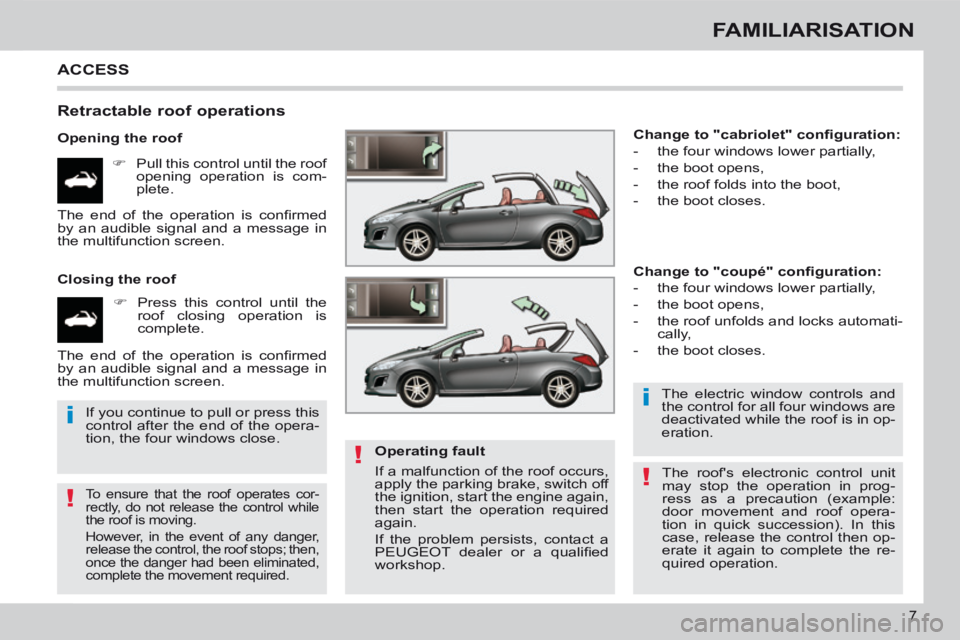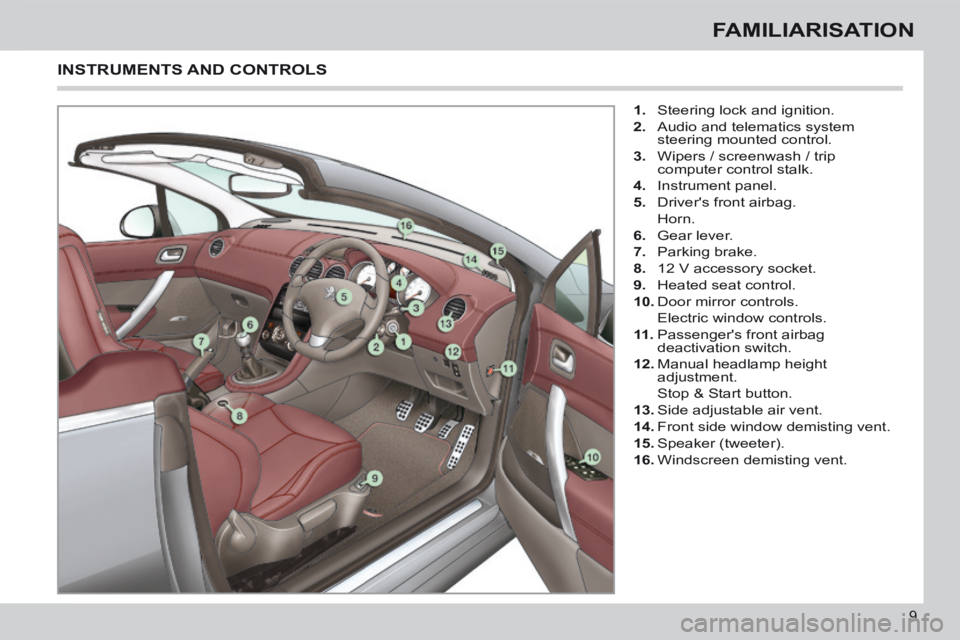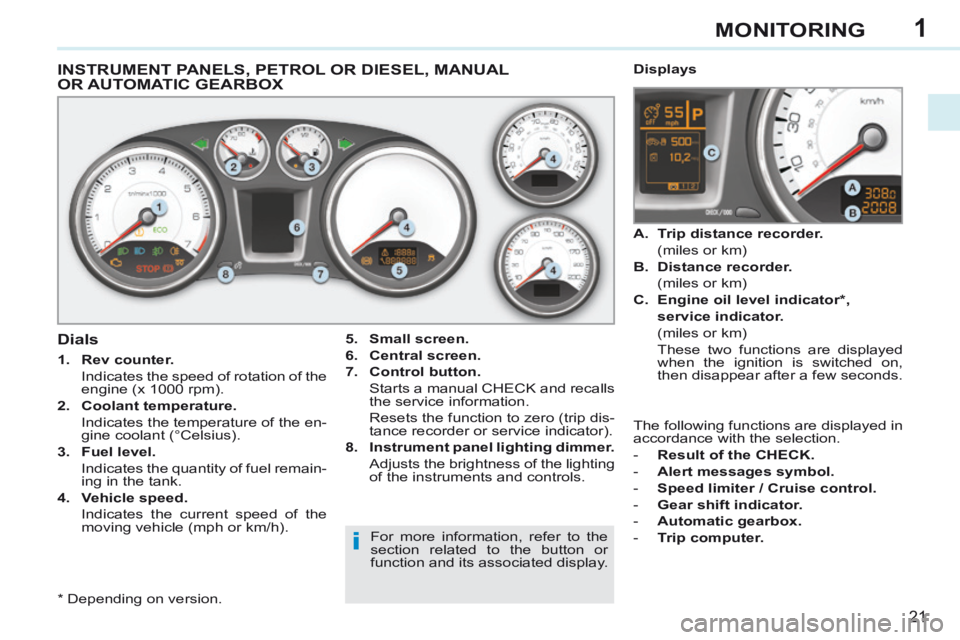2013 PEUGEOT 308 CC ignition
[x] Cancel search: ignitionPage 9 of 268

!
i
!
i
!
7
FAMILIARISATION
ACCESS
Retractable roof operations
Opening the roof Pull this control until the roof opening operation is com-
plete.
Closing the roof Press this control until the roof closing operation is
complete. Change to "cabriolet" confi guration:
- the four windows lower partially,
- the boot opens,
- the roof folds into the boot,
- the boot closes.
Change to "coupé" confi guration:
- the four windows lower partially,
- the boot opens,
- the roof unfolds and locks automati-
cally,
- the boot closes.
To ensure that the roof operates cor-
rectly, do not release the control while
the roof is moving.
However, in the event of any danger,
release the control, the roof stops; then,
once the danger had been eliminated,
complete the movement required.
Operating fault
If a malfunction of the roof occurs,
apply the parking brake, switch off
the ignition, start the engine again,
then start the operation required
again.
If the problem persists, contact a
PEUGEOT dealer or a qualifi ed
workshop. The electric window controls and
the control for all four windows are
deactivated while the roof is in op-
eration.
The end of the operation is confi rmed
by an audible signal and a message in
the multifunction screen.
The end of the operation is confi rmed
by an audible signal and a message in
the multifunction screen.
If you continue to pull or press this
control after the end of the opera-
tion, the four windows close.
The roof's electronic control unit
may stop the operation in prog-
ress as a precaution (example:
door movement and roof opera-
tion in quick succession). In this
case, release the control then op-
erate it again to complete the re-
quired operation.
Page 11 of 268

9
FAMILIARISATION
1. Steering lock and ignition.
2. Audio and telematics system steering mounted control.
3. Wipers / screenwash / trip computer control stalk.
4. Instrument panel.
5. Driver's front airbag.
Horn.
6. Gear lever.
7. Parking brake.
8. 12 V accessory socket.
9. Heated seat control.
10. Door mirror controls.
Electric window controls.
11 . Passenger's front airbag
deactivation switch.
12. Manual headlamp height adjustment.
Stop & Start button.
13. Side adjustable air vent.
14. Front side window demisting vent.
15. Speaker (tweeter).
16. Windscreen demisting vent.
INSTRUMENTS AND CONTROLS
Page 17 of 268

21 23
177 177
67
71
95
129
15
FAMILIARISATION
MONITORING
Instrument panel Switch panel
A. With the ignition on, the needle should
indicate the level of fuel remaining.
B. With the engine running, its associ- ated low level warning lamp should
go off.
C. With the ignition on, the oil level in- dicator * should display that the level
is correct for a few seconds.
If the levels are not correct, top up the
levels which are low. Illumination of the indicator lamp indicates
the status of the corresponding function.
A. Emergency call in progress.
1. With the ignition on, the orange and
red warning lamps come on.
2. With the engine running, these warning lamps should go off.
If warning lamps remain on, refer to the
table concerned.
Warning lamps
B. Deactivation of the alarm volumetric monitoring.
C. Central locking.
D. Deactivation of the DSC/ASR systems.
E. Deactivation of the front and rear parking sensors.
F. Access to PEUGEOT services.
* Depending on version.
Page 18 of 268

i
101 97, 101 63
16
FAMILIARISATION
Passenger's front airbag
STARTING
1. Insert the key.
2. Select position:
"OFF" (deactivated), with "rearward
facing" child seat,
"ON" (activated), with front passen-
ger or "forward facing" child seat.
3. Remove the key keeping the switch in the new position. 1. Stop position.
2. Ignition on (Running ) position.
3. Starting position.
A. Front and/or rear seat belts not fas-
tened / unfastened warning lamp.
B. Front left seat belt warning lamp.
C. Front right seat belt warning lamp.
D. Rear right seat belt warning lamp.
E. Rear left seat belt warning lamp.
F. Passenger's front airbag deactivated
warning lamp.
G. Passenger's front airbag activated warning lamp.
Seat belts and passenger's
front airbag
PASSENGER SAFETY
Ignition switch
Avoid attaching any heavy objects
to the key which would weigh down
on its shaft in the ignition switch;
this could cause a malfunction.
Page 19 of 268

!
i
i
11 9 120
17
FAMILIARISATION
DRIVING SAFELY
Stop & Start
The "ECO" warning lamp comes on
in the instrument panel and the en-
gine automatically goes into standby: The "ECO" warning lamp goes
off and the engine restarts auto-
matically:
You can deactivate the system at any
time by pressing the "ECO OFF" but-
ton; the warning lamp in the button
comes on. Deactivation / Reactivation
Going into engine STOP mode Going into engine START mode
- with a manual gearbox: at speeds below 12 mph (20 km/h), when you
place the gear lever into neutral,
and you release the clutch pedal.
In some circumstances, STOP mode may
not be available; the "ECO" warning lamp
fl ashes for few seconds, then goes off.
- with a manual gearbox: when you fully depress the clutch pedal.
If you engage a gear without fully
depressing the clutch pedal, the
engine will not restart automatical-
ly. An alert message is displayed
asking you to fully depress the
clutch pedal. The system is reactivated auto-
matically at every new start using
the key.
Before refuelling or doing anything
under the bonnet, you must switch
off the ignition using the key.
In some circumstances START mode
may be invoked automatically; the
"ECO" warning lamp fl ashes for a few
seconds, then goes off.
Page 23 of 268

1
i
21
MONITORING
INSTRUMENT PANELS, PETROL OR DIESEL, MANUAL OR AUTOMATIC GEARBOX
5. Small screen.
6. Central screen.
7. Control button.
Starts a manual CHECK and recalls the service information.
Resets the function to zero (trip dis- tance recorder or service indicator).
8. Instrument panel lighting dimmer.
Adjusts the brightness of the lighting of the instruments and controls. Dials
1. Rev counter.
Indicates the speed of rotation of the engine (x 1000 rpm).
2. Coolant temperature.
Indicates the temperature of the en- gine coolant (°Celsius).
3. Fuel level.
Indicates the quantity of fuel remain- ing in the tank.
4. Vehicle speed.
Indicates the current speed of the moving vehicle (mph or km/h). A. Trip distance recorder.
(miles or km)
B. Distance recorder.
(miles or km)
C. Engine oil level indicator * ,
service indicator.
(miles or km)
These two functions are displayed when the ignition is switched on,
then disappear after a few seconds.
Displays
For more information, refer to the
section related to the button or
function and its associated display. The following functions are displayed in
accordance with the selection.
- Result of the CHECK.
- Alert messages symbol.
- Speed limiter / Cruise control.
- Gear shift indicator.
- Automatic gearbox.
- Trip computer.
* Depending on version.
Page 24 of 268

1
i
22
MONITORING
INSTRUMENT PANELS, PETROL OR DIESEL, MANUAL OR AUTOMATIC GEARBOX, WITH NAVIGATION
* Depending on version.
Dials
1. Rev counter.
Indicates the speed of rotation of the engine (x 1000 rpm).
2. Coolant temperature.
Indicates the temperature of the en- gine coolant (°Celsius).
3. Fuel level.
Indicates the quantity of fuel remain- ing in the tank.
4. Vehicle speed.
Indicates the current speed of the moving vehicle (mph or km/h). 5. Small screen.
6. Central screen.
7. Control button.
Starts a manual CHECK and recalls
the service information.
Resets the function to zero (trip dis- tance recorder or service indicator).
8. Instrument panel lighting dimmer.
Adjusts the brightness of the lighting of the instruments and controls.
For more information, refer to the
section related to the button or
function and its associated display. Displays
A. Trip distance recorder.
(miles or km)
B. Distance recorder.
(miles or km)
C. Engine oil level indicator * ,
service indicator.
(miles or km)
These two functions are displayed when the ignition is switched on,
then disappear after a few seconds.
The following functions are displayed in
accordance with the selection.
- Result of the CHECK.
- Alert messages.
- Speed limiter / Cruise control.
- Gear shift indicator.
- Automatic gearbox.
-
Navigation - Guidance / Trip computer.
- Repeat of the current speed.
Page 25 of 268

1
!
23
MONITORING
The illumination of a warning lamp
is always accompanied by the dis-
play of an additional message, to
assist you in identifying the fault.
If you encounter any problems,
contact a PEUGEOT dealer or a
qualifi ed workshop.
Warning and indicator lamps
Visual indicators which inform the driver of
the occurrence of a fault (warning lamp) or
of the operation of a system (operation or
deactivation indicator lamp). Associated warnings
The illumination, fi xed or fl ashing, of certain
warning lamps may be accompanied by an
audible signal and a message in the screen.
Depending on your version of instrument
panel, illumination of the warning lamp is
also accompanied by:
When the ignition is switched on
Certain warning lamps come on for
a few seconds when the ignition is
switched on.
When the engine is started, these warn-
ing lamps should go off.
If they remain on, before moving off,
refer to the information for the warning
lamp concerned. Warning lamps
When the engine is running or the ve-
hicle is being driven, the illumination of
one of the following warning lamps in-
dicates a fault which requires action on
the part of the driver.
- a symbol in the central instrument panel screen and a message in the
multi-function screen,
or
- a symbol and a message in the central instrument panel screen.